As I sit in my sun porch writing these words, my sweaty fingers are slipping on the keys one minute, sticking the next. My trackpad is glitching up, too. My computer does not like my perspiration. It’s 100 degrees Fahrenheit with 70 percent humidity at my house on Cape Cod, Massachusetts, making it 142 degrees.
I know I have it easy compared to . It’s steamy here in New England, but I’m not in any danger of (as long as I vacate this sun porch, which I’m doing right now) and my close proximity to the ocean gives me a bit of relief. But that’s not the case for millions of people in other parts of the country where the current heat wave is unbearable, downright dangerous, and inescapable.
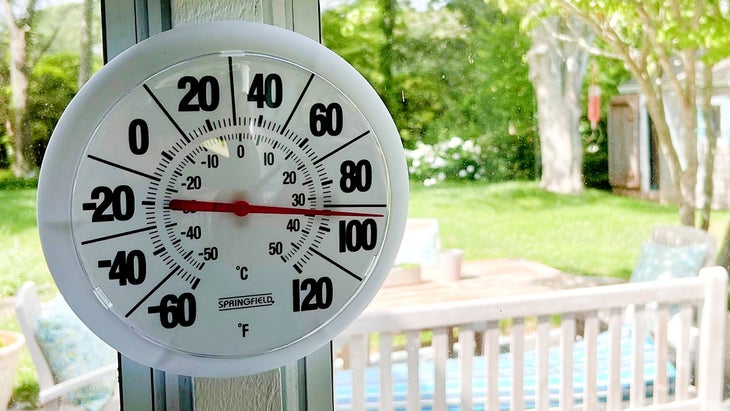
Extreme weather phenomenon like heat domes—where the atmosphere traps warm air, creating dangerously high temperatures—are becoming the norm. According to a 2022 in The New England Journal of Medicine, “Climate change is causing a global increase in average temperatures and increasing the frequency, duration, and intensity of extreme heat events, resulting in unprecedented levels of heat exposure.”
Soaring temperatures are deadly. In , the U.S. saw approximately 11,000 heat deaths, and that’s likely a conservative number. “Heat is absolutely no joke,” says Kim Knowlton, assistant clinical professor at Columbia University’s Mailman School of Public Health who specializes in heat and ozone studies.
Symptoms of hyperthermia, a.k.a. heat illness, include dizziness, nausea, fatigue, rapid heart rate, and passing out. Heat stroke is the most severe iteration, which can lead to organ failure, brain damage, and death.
“So many Americans don’t have access to or can’t afford to operate an air conditioner. People don’t take it seriously enough,” says Knowlton. She believes that athletes and outdoor enthusiasts are particularly vulnerable to heat illness because we’re healthy and strong and some of us even love a good, sweaty sufferfest. “It’s easy to be cavalier about discomfort when you’re used to it,” she says. “But layer on extreme heat and it can get really dangerous really fast.”
For many of us, heat poses dangers—or, at the very least, extreme discomfort—in our home lives. I work from home and lack the luxury of an air-conditioned office in a high rise. Sometimes, the soaring temperatures makes a day of work feel like a trip to the sauna.
My house does have some infrastructure for regulating temperature—I have mini-split air conditioning units as well as a heat pump. But I’m reticent to turn on these devices, due to the energy use and cost. According to the , electricity consumption for cooling homes and commercial buildings in the U.S adds up to about 424 billion kilowatt hours per year. In terms of greenhouse gas emissions, that’s the equivalent of cranking 45.4 coal plants for a year.
But just because you’re an environmentally-conscious person doesn’t mean you have to endure a summer of agony. There are plenty of ways to stay cool without flipping on an electric device. So, in order to save money and carbon emissions this summer, I’ve been on a mission to find low-cost, low-impact hacks to stay cool at home, sans A/C. All of these tricks, tested and approved (by me) and pulled together with stuff I had lying around the house, helped keep me cool during the July 2024 heatwave.
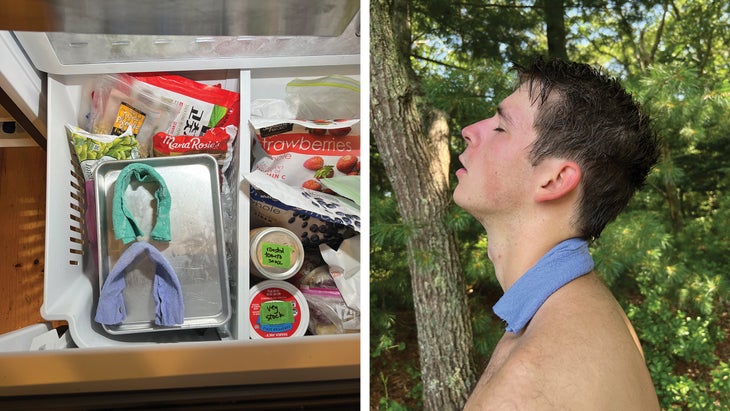
1. Make a Cool Collar
This is my absolute favorite cooling trick. First, take a towel (ideal size is about 18 by 10 inches), wet it thoroughly, and wring it out. Second, roll the damp towel lengthwise and form it into a horseshoe shape. Third, lay it flat in the freezer for about an hour. Once frozen solid, hook it around your neck for a long-lasting cooling power. I experimented with lots of different fabrics: cotton bandanas, dish towels, typical wash cloths, and polyester Buffs. All of those dry out and become lukewarm too quickly, but I found a very clear winner. These ($2 each), made of a soft, highly absorbent material called viscose (derived from wood pulp), stay damp and cool for well over an hour in scorching temps. I’ve taken to wearing my collar on walks, hikes, and even during Zoom calls. You’re welcome.
Why it works: The carotid arteries, which supply blood to the head and brain, run up each side of the neck and are one of our pulse points, where blood vessels are close to the skin surface. When you apply a cold compress to a pulse point, there’s an immediate cooling effect. One published in The Journal of Athletic Training also suggests that during physical exertion, cooling the base of the neck where the thermoregulation center lives, dampens our perception of heat discomfort and sends that signal to our brain.
2. Cool Your Jets
This method may sound crazy, but it really works, as any hot hiker who dips their feet in a river knows. Fill a basin with ice water and soak your feet. Combine this tip with No. 1 and you’ll be crushing the heat from head to toe.
Why it works: We have cooling points on the tops or our feet and ankles. shows that immersing our feet in cool water is an effective way to lower core body temperature.
3. Make a Cooling Mist
Fill a spray bottle with equal parts water and witch hazel, then add about 15 drops of any combination of peppermint, spearmint, or eucalyptus essential oil. Store in the fridge and give yourself a spritz as needed.
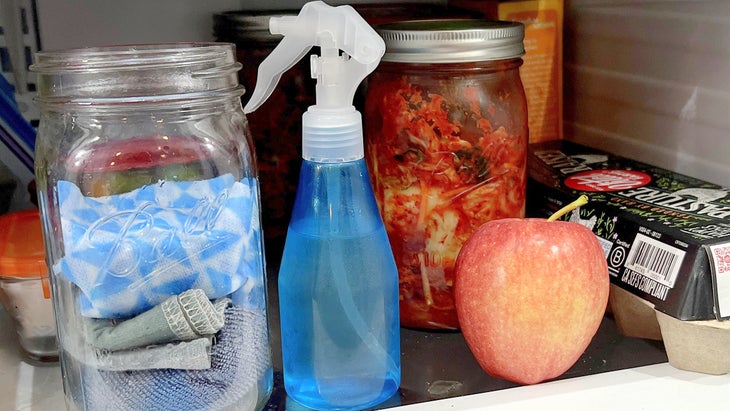
Why it works: Skin is the biggest organ in our body, says Knowlton, and keeping it moist promotes evaporative cooling. As water on the surface of the skin evaporates it pulls heat from our bodies and cools us down. The menthol oils activate the cold-sensitive receptors in our skin. It’s a quick and temporary solution, but it feels (and smells) really nice.
4. Make Wet Wipes
Start off by filling a big pot with water. Next add a bunch of drops of your favorite essential oil. I like peppermint and spearmint for their cool, refreshing vibes. Then submerge your choice of bandanas, Buffs, dish towels, or washcloths. Let them soak in the aromatherapy for 30 minutes or so. Lightly wring them out and fold them into a large mason jar. Refrigerate. Grab a wipe anytime you need a quick spurt of coolness. Wipe down your arms, legs, face after a workout, or wear it around your neck until it warms up.
Why it works: See 1 and 3.
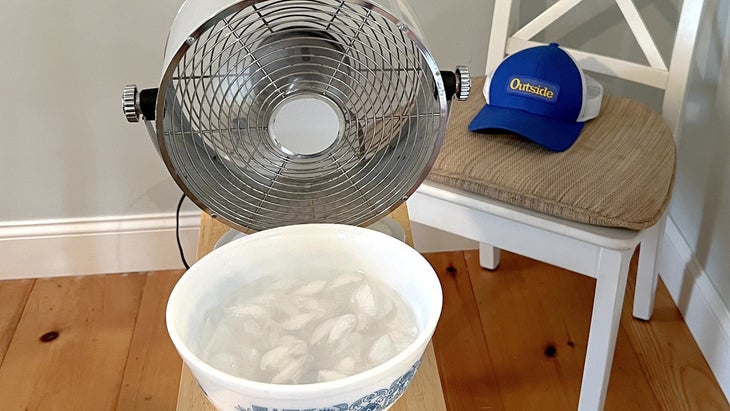
5. Hack Your Fan
Did you know that in dry heat, fans can sometimes do more harm than good? According to a researcher quoted in , “fans at any temperature up to 104° Fahrenheit, where there is some kind of humidity, are beneficial. But as the temperature goes higher, if it’s dry, then fans are progressively less useful and potentially detrimental.” It’s because when the air temperature is greater than that of your skin, the opposite of evaporation occurs: the hot air flows into your body rather than out of it. But you can create a low-tech mini A/C unit if you have access to some ice. Fill a bowl with ice (or a mixture of ice and water) and place it directly in front of a fan pointed at you.
Why it works: It’s pretty simple. As air passes over the ice, it cools down and the fan circulates it around the room, mimicking an A/C unit which uses much more energy.
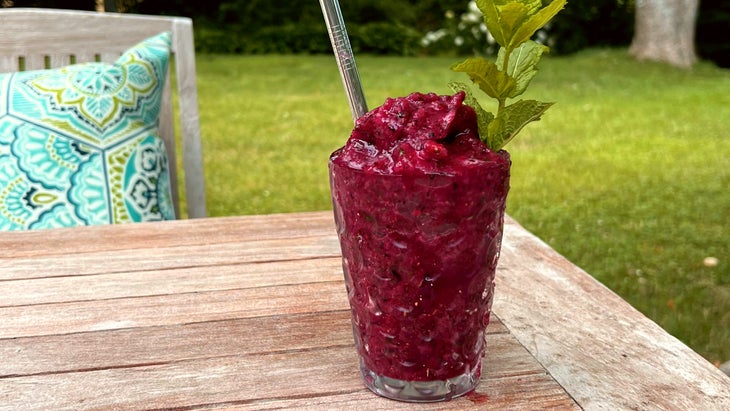
6. Drink a Slushy
Grab a sugary icy beverage at your local convenience store, or better yet, make a healthy one. Start by placing 6 large frozen strawberries, 3 chunks of frozen watermelon, a handful of blueberries, 6 ice cubes, fresh mint (the more the better), and the zest and juice of one lime into a high powered blender. Then, with the motor running, add water about 1/4 cup at a time, pushing fruit down the sides of the blender with a rubber spatula, until you get the perfect slushy consistency.
Why it works: Especially on high humidity days, a slushy is a great (and tasty) way to bring your internal temperature down, says Knowlton. “Sip it, don’t chug it, for a sustained and gradual cooling.” Other hydrating ingredients to experiment with: coconut water, cucumbers, citrus, stone fruits, apples, and pears.
“There’s been some controversy about whether hot or cold drinks are most efficient at cooling,” says Knowlton. “The rationale is that on a hot day, drinking hot tea will make you sweat, and the evaporation of that sweat offers high-efficiency cooling. That would be the case on lower-humidity days, but a nice cold slushy is so much more fun.”
7. Start the Night Off Cool
Generously mist a flat twin sheet with your cooling spray or plain water. Fold it and place it in the freezer an hour before bedtime. When it’s time to hit the sack, unfurl your sheet of coolness and climb under. A deftly aimed fan makes for a lovely end to a steamy day.
Why it works: Falling asleep when it’s hot can be brutal. This technique provides a fleeting (15 to 30 minutes, depending) burst of sweet, cool comfort, which is sometimes all you need to start the night off right.
Doing right by the planet can make you happier, healthier, and—yes—wealthier. �����ԹϺ���’s head of sustainability, Kristin Hostetter, explores small lifestyle tweaks that can make a big impact. for her twice monthly newsletter or write to her at climateneutral-ish@outsideinc.com.
